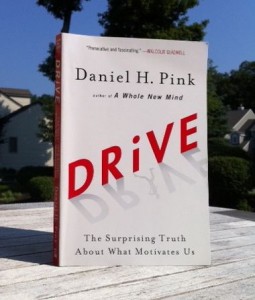Books We Trust: Drive by Dan Pink
 Daniel H. Pink talks to us about Drive: The Surprising Truth About What Motivates Us, his recent and highly successful book.
Daniel H. Pink talks to us about Drive: The Surprising Truth About What Motivates Us, his recent and highly successful book.
The Drive Behind “Drive”
Charles Green: In the dedication of Drive, you mention Sophia, Eliza and Saul, “the surprising trio that motivates me.” What got you started on looking into this whole question of human motivation?
Dan Pink: Our kids were part of the impetus, I guess. But Drive is mostly the outgrowth of A Whole New Mind, which I published in 2005. That book argues that we’re moving from a world built less on logical, linear, left-brain, spreadsheet abilities–and more on the hard-to-outsource, hard-to-automate, artistic, empathic right-brain abilities.
After that book, people said to me: “If you’re right about this shift in abilities, then how do we motivate people to do this sort of work?” I didn’t have a clue. But I knew there was a body of research on human motivation. So I started exploring it. And I quickly realized that it was a vast body of research–and much of it overturned orthodoxies I didn’t even realize were orthodoxies.
Motivation 2.0 and 3.0
Charlie: In the book you talk about Motivation 2.0, which still has a hold on many managers and businesses: the idea that without extrinsic motivators of rewards and punishments, people at work will be unmotivated, aimless and unproductive–that therefore employees and teams need to be motivated and managed externally. How would you tie this view of human motivation to trust?
Dan: It’s inextricably linked to the idea of trust. If you believe you can’t trust employees, then you have to put in place all kinds of mechanisms for control. There’s no way around that. If you think other people can’t be trusted, then the Motivation 3.0 approach I write about is a total non-starter.
Charlie: Your idea of Motivation 3.0 stems from the understanding that we, as human beings, are intrinsically motivated to take on responsibility, to look for creative and intellectual challenges and to solve problems. Can you talk a little more about the three factors which make up Motivation 3.0 and lead to production and satisfaction for individuals at work:
- Autonomy
- Opportunity for Mastery (competence)
- Purpose (relatedness)
Dan: Sure. The idea here is that if you want people to be motivated to do well on creative, conceptual, complex work, you have to pay them enough–and offer these three elements.
Autonomy is the drive to direct our own lives. People generally perform better when they have a little more autonomy over what they do, when they do it, how they do it, and with whom they do it.
Mastery is the drive to get better at something that matters and to make progress in our work. It’s hugely powerful and often ignored inside of organizations.
And purpose is our drive to contribute and to know that what we do has an influence in the wider world. For most of the work people do today, autonomy, mastery, and purpose are generally far more effective than carrots and sticks.
Motivation, Management and Trust
Charlie: “Managing” from the point of view of 3.0 requires a lot of trust of individuals; it’s a far cry from our traditional mindset around “managing” which equates largely to directing and controlling. Managing from a belief in Motivation 3.0 really requires that the “manager” trust her staff to work hard, be productive, and do the right thing. What would you say to a manager who is afraid to take that risk of trusting?
Dan: I’d say three things. First, take a leap of faith and give it a try. Be willing to let people surprise you.
Second, think about the costs of not trusting. You’re basically saying you prefer controlled mediocrity (which is what you get with control and lack of trust) rather than a chance to do something amazing.
Third, ask yourself, “Can you be trusted?” “Can your spouse or partner be trusted?” “Can your best friend be trusted?” Maybe the people in your organization aren’t all that different than the people in your life.
Charlie: If 20th century “management” thinkers had had a Motivation 3.0 mindset, it seems to us that it could have been applied in routine, even production-line work–because basic human drives haven’t changed that much in 100 years. Do you think that Motivation 3.0 is only applicable to the 21st century ways of working? Or is it that Motivation 3.0 is just more necessary to 21st century workers and 21st century work?
Dan: It’s an interesting question. As you know from the book, I’m trying to look at what science–not folklore or our intuitions–says about motivation. And the science is pretty clear: for routine, algorithmic work, “If-then” motivators–as in “If you do this, then you get that”–are effective.
But that doesn’t mean “if-then” is the only way to create a motivating environment for those sorts of tasks. It’s possible, for instance, to help people doing routine work sculpt their jobs to make them more autonomous and better avenues for mastery. Likewise, people often do routine work a bit better when they have some amount of autonomy over how they do their work–and when they know how what they do contributes to a larger whole. So Motivation 3.0 is essential for creative, conceptual work. But it can also be effective for other types of work.
Innovation and Trust
Charlie: Motivation 3.0 seems to describe a fertile atmosphere for innovation. How would you link innovation and trust?
Dan: People don’t innovate when they feel others don’t trust them. Period. Innovation often depends on the absence of constraints. And mistrust is one of the most constraining forces around.
Charlie: Interesting; that’s exactly the linkage defined by Ross Smith at Microsoft and by Robert Porter Lynch. They both emphasize the lowering of risk that trust implies, which then permits people to openly engage with each other.
Dan: Not surprising. Mistrust is terrific for making people comply; it stinks for helping people engage.
Results-Only Work Environments
Charlie: In your book you give some wonderful examples of ROWE – Results-Only Work Environments, in which employees have great freedom as to when, where and how they work as long as the work gets done. How close are we to seeing the wider spread of that way of thinking? How does the technology, which lets people work outside their offices, contribute to even informal ROWEs?
Dan: I think the adoption of these new approaches will follow the general pattern of technology adoption in general. We often overhype the impact of new technologies in the short run–but underhype them in the long run. So I doubt these approaches will be incredibly widespread in the next 2 years. But in the next 10 years, they’ll become the norm.
The Talent Picks the Team
Charlie: When you talk about autonomy, you examine having influence or control over Task, Time, Technique and Team. Talk to us about the Team element of this equation. For example, putting together a “pick-up” team of like-minded people, or those who have skills you need—isn’t that hard to do in any work environment?
Dan: Team is a tough one. But Facebook has a really innovative approach to this. The company hires new computer scientists and software engineers and for the first few weeks puts them through a Facebook bootcamp. As part of that experience, the new hires interview around the company–with various product teams, technology teams, and so on. Then when the bootcamp ends, the newly hired engineer decides which team she wants to work for. That is, the company picks the talent. But the talent picks the team.
A State of “Flow”
Charlie: You mention Mihaly Csikszentmihalyi’s surprising finding in Flow that people reach a flow state–or being in a state of focus or complete absorption so that time disappears–more through satisfying work than through their leisure activities. Why is that?
Dan: Csikszentmihalyi says it has less to do with the difference between work and leisure per se–and more to do with the difference between activity and passivity. Most work is at least somewhat challenging–and it requires some amount of effort. But many kinds of leisure are passive. Think watching television. There’s no challenge presented, no effort required.
So, since flow depends on the challenge being matched to one’s ability, passive leisure never results in flow. That said, active leisure–think rock-climbing or oil painting–does produce flow. The key, I think, is to fashion our lives–at school, at work, at home–around being active and engaged. Human beings weren’t meant to be passive and inert.
Charlie: Fascinating, Dan; thanks so much for taking time to explore this with me, I appreciate it.
Dan: Not at all.
Books We Trust: Drive by Dan Pink is the third installment in our Books We Trust series.
Previous Books We Trust interviews include:
- Jeb Brooks on You’re Working Too Hard to Make the Sale, by Bill Brooks and Tom Travisano; and
- Jill Konrath on Selling to Big Companies.

 Ralph Catillo is an Account Executive with
Ralph Catillo is an Account Executive with  We’re about halfway through our countdown of Trust Tips leading up to the release of “The Trusted Advisor Fieldbook: A Comprehensive Toolkit for Leading with Trust,”
We’re about halfway through our countdown of Trust Tips leading up to the release of “The Trusted Advisor Fieldbook: A Comprehensive Toolkit for Leading with Trust,”  Gregory (Scotland Yard detective): “Is there any other point to which you would wish to draw my attention?”
Gregory (Scotland Yard detective): “Is there any other point to which you would wish to draw my attention?” It was five months ago, but I remember it like yesterday.
It was five months ago, but I remember it like yesterday. We all know the power of stories in business. We know too that it’s the heroes who give stories power. The hero may be a person, a brand, a company, or it may be the listener. When the story and the hero are strong, it resonates with the audience.
We all know the power of stories in business. We know too that it’s the heroes who give stories power. The hero may be a person, a brand, a company, or it may be the listener. When the story and the hero are strong, it resonates with the audience. What would you do?
What would you do? We’re lighting up the twittersphere with a series of daily Trust Tips, counting down the work days until our upcoming book, “
We’re lighting up the twittersphere with a series of daily Trust Tips, counting down the work days until our upcoming book, “ This post comes from our upcoming book,
This post comes from our upcoming book,  Ross Smith of Microsoft is a pioneer in applying trust to real-world management issues—particularly creativity, innovation and employee engagement. I first interviewed him in the inaugural issue of Trust Quotes,
Ross Smith of Microsoft is a pioneer in applying trust to real-world management issues—particularly creativity, innovation and employee engagement. I first interviewed him in the inaugural issue of Trust Quotes,